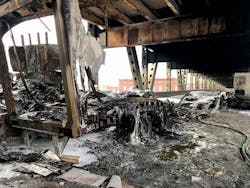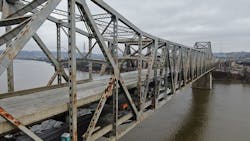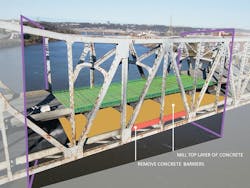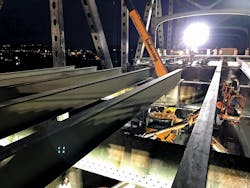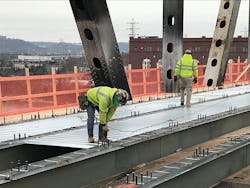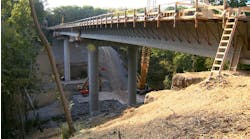Repairs to the Brent Spence Bridge keep traffic moving on one of the busiest truck routes in the nation
By: Stacee Hans and Jason Stith
The Brent Spence Bridge is a double-decker, cantilevered truss that carries Interstates 71 and 75 across the Ohio River between Covington, Kentucky and Cincinnati, Ohio.
A major thoroughfare for both local and national traffic with an average daily traffic of 160,000, the bridge’s northbound traffic is carried by the lower deck while southbound traffic is carried by the upper deck. The Brent Spence Bridge and its approaches are key elements of the nation’s interstate system, connecting to 10 states from as far north as Michigan to as far south as Florida and serving as one of the busiest truck routes in the U.S. Almost 3% of the nation’s gross domestic product (GDP) annually crosses the bridge and a significant maritime presence operates under the bridge on the Ohio River.
Traffic on the bridge came to a halt when a call was placed to 911 at 2:45 a.m. on Nov. 11, 2020. A two-semi collision had occurred moments before, with fire engulfing both rigs and raging to temperatures in excess of 1,500°F. The incident was between panel points P17’ and P18’ on the northbound lower deck, which is the start of the 453-ft suspended span on the Kentucky side. In the ensuing minutes, vehicles were abandoned as stuck drivers ran off the bridge to safety. Fire crews fought the blaze on the bridge deck, as well as from a boat in the Ohio River. The situation became even more critical as a fuel truck was located within the stalled traffic and without the swift actions taken by the first responders, it could have easily gone up in flames as well. The immediate response resulted in zero injuries or fatalities from the incident.
With no warning or time to prepare, the Kentucky Transportation Cabinet (KYTC) and Ohio Department of Transportation (ODOT) quickly mobilized to close the bridge in both directions. The U.S. Coast Guard was also contacted and the decision to shut down river traffic was made and implemented via a Notice to Mariners. In a matter of hours, the impacts of closing a major U.S. interstate river crossing and a major inland waterway shipping route were already being felt. Governor Andy Beshear of Kentucky clearly laid out the objective in short order: “We want to get this job done and we want to get it done quickly, but it has to be done safely.”
Springing into Action
As the sun rose on the morning of Nov. 11, just hours after the 911 call, crews from KYTC, ODOT, the Federal Highway Administration (FHWA), and lead consultant Michael Baker International were already mobilizing. The next day, they would be joined by inspection partners at Palmer Engineering, Burgess & Niple, and Stantec. The Kenton County Emergency Management office became the “War Room” in which meetings, calls, and activities were coordinated. This pre-construction work encompassed five major work areas: maintenance of traffic (MOT); inspection; design; public awareness; and construction procurement. All five areas were addressed in parallel and communicated in real-time to the highest levels of Kentucky government to ensure resources were available and any obstacles to progressing the delivery of the project were removed.
As traffic was rerouted to other crossings, a plan was developed to begin inspection and assessment. This included:
- Assessing the overall structural condition of the bridge
- Conducting hands-on inspection within the heat affected zone
- Cursory inspection of remaining bridge items outside of heat affected zone with a focus on the bearings, joints, and wind locks
- Planning for destructive testing of steel and concrete samples within the heat affected zone and non-destructive testing at additional locations within the heat affected zone
The inspection teams utilized a number of methods for the inspection, including rope access techniques, lifts, and unmanned aerial systems (UAS) to inspect the entire structure. Visual inspection techniques, along with magnetic particle non-destructive testing, were also performed.
Based on the results from the inspection, the team determined that the major repair items were the stringers of the upper deck and the associated concrete deck. The scope of work for the rehabilitation plans included:
- Replacing upper concrete deck, wearing surface, and concrete barriers from PP 16’ to PP 20’
- Replacing upper steel stringers and lateral bracing from PP 17’ to PP 19’
- Replacing miscellaneous steel at upper finger joint
- Removing, cleaning and resetting upper finger joint and drainage scuppers
- Replacing upper deck electrical wiring, junction boxes, and conduit
- Replacing lower deck wearing surface from PP 16’ to PP 21’
- Replacing lower deck concrete barriers from PP 17’ to PP 19’
- Replacing fixtures, electrical wiring, junction boxes, and conduit between lower and upper decks
Expediting the Design Process
In order to expedite the award of a construction contract, project team members from KYTC, FHWA, the consultant design team from Michael Baker and other project partners looked for creative efficiencies in the design process. Real-time information was relayed directly from the inspection teams to the design team, including the identification of the heat affected zone (HAZ). To offset supply delays, KYTC even secured steel beams anticipated to be needed for the repairs.
The project team quickly decided that the most efficient way to repair the bridge would be to replace all damaged components in-kind when possible or design them to be equal or better than the current bridge. The mindset was to keep the actual design and repair documents as simple as possible and only make modifications where necessary, allowing the team to use existing design plan sheets/shop drawings for much of the design. Components were also reused if they were not damaged.
Stringers of the upper deck and the associated concrete deck were visibly damaged. Additional obvious damage was to the lower bridge deck, which was spalled in divots up to 3 in. deep. One of the most critical elements of the bridge was the built-up box section vertical hanger that supports the 453-ft suspended span over the river. Each of these four members supported more than 5 million lb of load. To ensure due diligence, Michael Baker performed an internal redundancy analysis. The study concluded that even with consideration of the full fracture of the thickest of the six plates that comprised the vertical member at PP 17’, it could still be categorized as redundant and carry the full load of the original design without overstress. Material testing was also performed on this vertical member. After the lab confirmed the material properties, along with an internal member redundancy analysis as an extra precaution, the Ohio River reopened to traffic.
Due to several rehabilitations and no complete plan set that showed a current full section of the deck, it became necessary to combine sections from several plan sets to develop the current deck and barrier configuration. The original deck had used truss bars, which are no longer typical in Kentucky, so they were replaced with straight bars. The new deck required a connection of new longitudinal slab bars to the existing concrete.
The final “Released For Construction” plans were provided to KYTC at 11 a.m. on Nov. 16, a mere five days after the initial incident. The plans also included 13 sheets of joint repairs that were already developed to repair the finger joints. Not-for-construction document packages had been shared with bidding contractors throughout the previous two days, allowing the final set to be shared at 11 a.m. and project bids to be received at noon. The construction contract was awarded later that afternoon to Kokosing Construction Co.
Commencing Construction
Shortly after Kokosing was selected as the project’s contractor, Governor Beshear announced a target completion date of Dec. 23, 2020. KYTC established three construction inspection teams to cover 24-hour inspection operations, each led by a seasoned construction engineer which allowed for clear decisions to be made in the field. KYTC also established a “backup” inspection crew that would be ready to step into action should any of the crews have to quarantine due to COVID-19 exposure. Daily update meetings between the KYTC construction project manager, construction team leads, project coordinator, and contractor project manager were established to ensure constant communication and coordination.
On Nov. 25, the demolition of the upper deck began. The same day, the first shipment of steel stringer beams for the upper deck was delivered to the site. Within days, the deck and affected stringers were removed and stringers were replaced. Following the erection of an upper deck shielding platform, deck pans were installed on the upper deck followed by reinforcing steel and deck/barrier replacement. The lower deck overlay was removed and replaced. Other maintenance repairs to the bridge and approach roadways were performed while the bridge was closed and access was safely and easily obtained.
Maintenance of Traffic
Initial MOT was installed based on the emergency nature of the incident but then transitioned to project-specific MOT. Unlike a typical KYTC construction project, MOT responsibility for this project was addressed outside of construction, both contractually and physically. There was no live traffic in the construction area of the project, allowing the construction contractor to focus only on construction aspects of the project. MOT responsibility was a clean break at the Ohio River; KYTC handled the MOT approach in Kentucky and ODOT oversaw the MOT in Ohio, with coordination between the states.
The MOT team was making real-time decisions and adjustments in the field based on observations and comments from local law enforcement partners and the public. Rerouting 160,000 vehicles per day required messaging to be extended outside of northern Kentucky and into the Lexington, Louisville, Indianapolis, Columbus, and Dayton markets. The MOT team also coordinated with outside groups and mapping agencies to ensure that the bridge closure was being shared through multiple channels.
Public Awareness
Due to the impact of the bridge closure, the project team identified early the importance of keeping the public informed on project progress and detour suggestions, partnering with Rasor Communications on public relations efforts. A project-specific website was created and shared across multiple media platforms. KYTC Secretary Jim Gray and his staff hosted weekly virtual press conferences and daily social media updates established a social media presence. This interaction created transparency with the public and emphasized the people doing the work, not just the technical details of the work being completed.
Reopening of the Brent Spence Bridge
On Dec. 21, Michael Baker and KYTC performed a final bridge and construction inspection, and on Dec. 22, both decks of the bridge were reopened. This incredible repair timeline included a mere five-day turnaround from the initial incident to construction letting and 41 days to return the bridge to service from the closure. The team was even able to open the bridge one day ahead of schedule, with overwhelmingly positive support from the community. This was due, in large part, to the comprehensive and transparent public awareness campaign that clearly identified the project goals, provided a clear and consistent message, and updated the public on the project schedule and daily activities.
The U.S. Department of Transportation authorized up to $12 million in Emergency Relief Reimbursement to assist the project. The efforts of the team allowed the project to come in at less than half of this allotted sum including costs for inspection, design, public awareness, and construction. This unfortunate incident now serves as a model for DOTs on how to effectively respond to an emergency closure of a critical infrastructure asset.
About The Author: Hans is the Executive Staff Advisor at the Kentucky Transportation Cabinet’s District 6. Stith is Technical Manager for Bridges at Michael Baker International.
